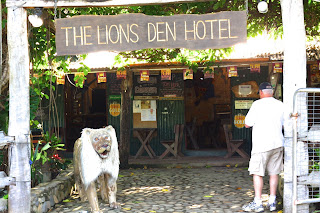 |
| Judith castes a lovely reflection as she stands at the 'Tip' in the sunshine |
Kay rested at the old well which is hidden behind the mangroves (look out for crocodiles)
 |
| The Somerset beach. |
Wrong thing to say!
While my group were doing a Weipa Mine Tour, I did a few tour guide related chores, then waited at Albatross Bay for their tour to finish.
There is usually some interesting bird activity going on and today wasn't any different.
I watched this Egret doing some fishing, using an unusual tactic - he seemed to be listening for the fish.

Then I got too close - and yes, he flew away. Funny thing though, he kept his neck outstretched for the first few wing flaps till he kinked it in true Egret style. He looks all neck and legs here.
Then I found this Striated Heron fishing using a different style.
This was a more concentrated killer look.
And it worked. A fish in the beak is worth two in the sea.
We headed down the Cape and called in to the Batavia Gold Fields ruins. In the early part of the 19th century, there was gold in them thar hills. Heavy machinery was brought in to crush the gold bearing rock in order to extract it. It took teams of 60+ bullocks to drag the machinery in and many months to get it there. When the gold ran out, the machinery stayed put to slowly rust away.

Some of the old machinery from the gold mines. The Batavia Fields had several ups and downs in the search for gold and was finally given up on around WWII.
Helen contemplates the feasibility of repairing this vehicle, while Judith looks sceptical. No-one has ever worked out exactly what make this vehicle is but one smart remark suggested that it was an Oztours bus (gotten lost).
Now during this tour, as in most others, there is usually at least one person who really wants to see a crocodile. The chances of seeing one are inversely proportional to the degree of wanting to see one.
I didn't like the chances. There was one glimmer of high possibility. Musgrave!
A couple of 'freshies' might have been put there on purpose
After arriving at Musgrave and putting our gear in 'the right rooms', we headed down to the billabong.
Nah, they weren't there - at first glance. Then someone spotted a little snout. Hooray, it was there. OK, not a 'saltie' but very photogenic with the still water providing a reverse image below the croc.
There is always a good show of flowers in the gardens of the Musgrave Telegraph Station. I was happy to get a shot of these late blooming Cooktown Orchids.
We were getting close to the end of our trip with Lakefield National Park being the next on our agenda. I made everyone get up and packed early as there is a lot to see on this leg.
There is an area in Lakefield called Nifold Plain. There are no trees at all over a large area, only magnetic termite mounds. This gives the are an eerie moonscape feeling.
A Brown Falcon watches us from his guide-post perch.
Lilies abound in the many waterholes throughout the Park. On the right is the tiny Snowflake Lily which can be easily overlooked till pointed out. The petals 'zip' together when the flower is submerged under water.
There is an enormous lagoon called Red Lily Lagoon which is completely dominated by these beautiful red Lotus Lilies Nelumbo nucifera .

These Scarlett Gums can be found along the southern end of Lakefield along Battlecamp Road. They grow across northern Australia and in a small area between Cooktown and Laura.
Our last stop before Cooktown was Isabella Falls. I waited patiently for a car to cross the causeway for my next photo. Soon I was rewarded with an obliging driver who wanted to know how fast I wanted him to go. "It's up to you", I said. "If you want an action photo with water spraying everywhere, go fast. If you want a nice photo with a reflection, go fast."
The driver was a man, so he went fast!








































